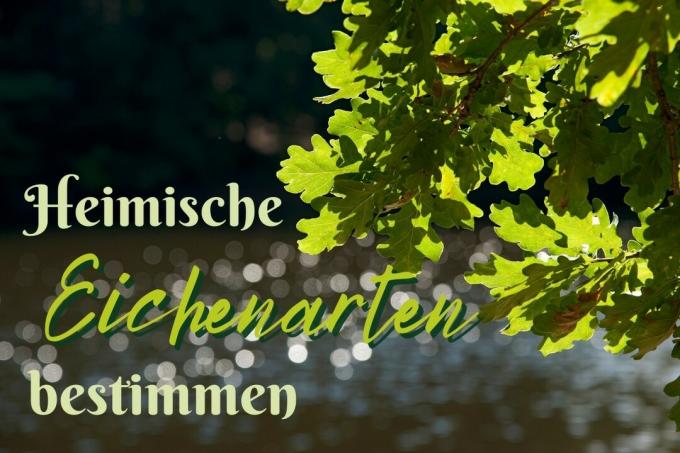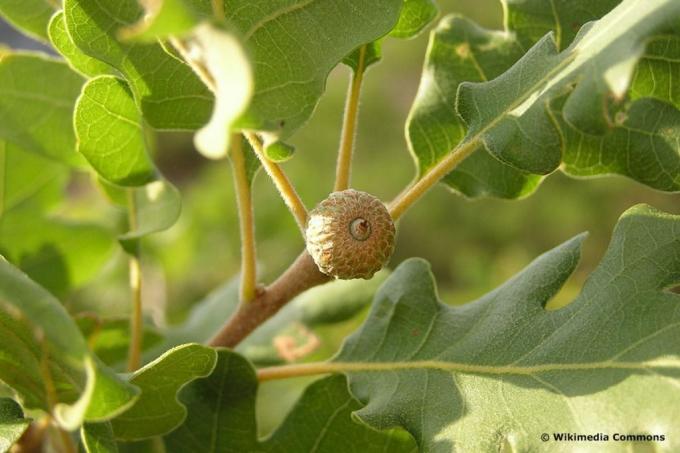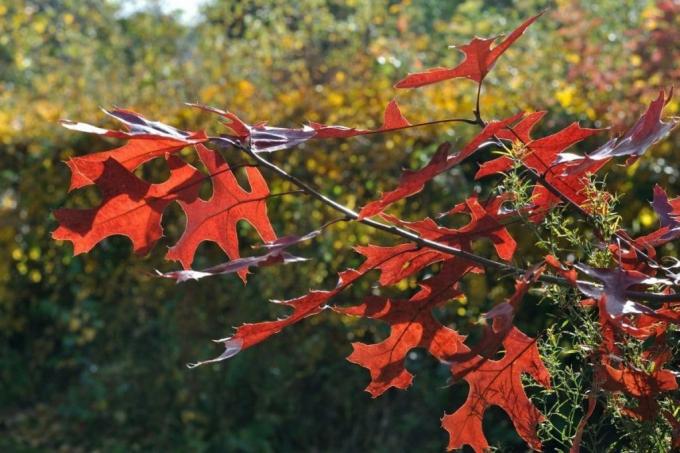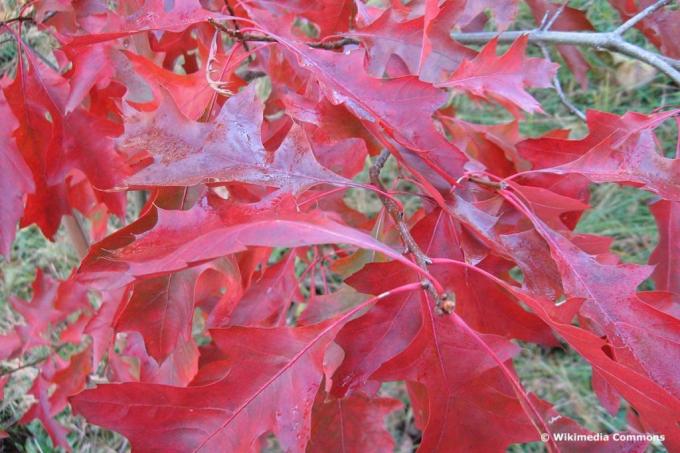
table of contents
- Native oak species
- Downy oak (Quercus pubescens)
- English oak (Quercus robur)
- Sessile oak (Quercus petraea)
- Naturalized oak species
- Evergreen oak (Quercus x turneri, "Pseudoturneri")
- Red oak (Quercus rubra)
- Scarlet oak (Quercus coccinea)
- Hungarian oak (Quercus frainetto)
- Zerr oak (Quercus cerris)
- Frequently asked Questions:
Native oak species such as the English oak and the sessile oak are widespread throughout Germany. Their share in the total forest area is a good 11 percent. Most of the naturalized species can be found in parks.
In a nutshell
- native oak species are among the most common tree species in German forests
- The regional focus is on the Palatinate Forest, the Spessart and the warm lowlands in Germany
- The red oak is the most common among the naturalized species
- In the open, the deciduous trees grow in sunny and partially shaded locations
Native oak species
The following oak species are native to Germany:
Downy oak (Quercus pubescens)
- Occurrence: parks, gardens, roadside
- Genuine forests in Germany: in the southwest of Baden-Württemberg (especially in the Kaiserstuhl), Thuringian Saale Valley
- Soil: sandy-loamy to very loamy, tolerates wet locations well

Growth:
- Height: up to 20 meters
- Crown: broad crown with sparsely protruding branches
- Trunk diameter: 40 to 50 centimeters, very old specimens up to 2.5 meters
Bark / branches:
- Bark: gray-brown, thick, coarsely feathered
- Branches: cracked bark
Sheet:
- Petiole: about 1.5 centimeters
- Leaf blade: oval or obovate to elliptical, curved, smooth leaf margin, 4 to 8 lobes, up to 12 centimeters long
- Upper side of the leaf: dark green
- Underside of leaf: hairy, gray-green tomentose
- Autumn color: yellow
Acorns:
- sitting singly or in heap (three to four acorns)
- 2 to 2.8 inches long
- Cup: hemispherical, hairy
- envelops the fruit to a quarter, at most up to half
English oak (Quercus robur)
- Another common name: German oak, summer oak
- Occurrence: parks, gardens, roadside, forest tree
- Soil: sandy-loamy to very loamy, rich in nutrients, deep
Note: Since the pedunculate oak is very adaptable, it also grows on alternately moist to wet soils as well as on dry sandy soils (oak-birch forest, oak-pine forest)

Growth:
- Height: up to 40 meters
- Crown: broad and rounded
- Trunk diameter: up to three meters, in free standing up to eight meters
Bark / branches:
- Bark: gray-green, glossy, smooth and thin (young trees); gray-brown, thick, deeply longitudinally fissured (older oaks)
- Branches: green-brown
Sheet:
- Petiole: up to one centimeter
- Leaf blade: deeply indented, 5 - 6 lobes, smooth leaf margin, wavy on the petiole, 10 to 15 centimeters long and 7 to 8 centimeters wide
- Upper side of the leaf: deep green, shiny
- Underside of leaf: lighter, e.g. T. blue-greenish
- Autumn color: golden brown
Acorns:
- in clusters (3 to 5 acorns)
- up to 3.5 inches long
- Fruit cup: stem up to 4 centimeters long
- envelops the fruit up to a third
Sessile oak (Quercus petraea)
- Occurrence: parks, gardens, roadside, forest tree
- Soil: sandy-loamy to very loamy, tolerates wet locations well

Growth:
- Height: up to 35 meters
- Crown: high arched with branches radiating outwards
- Trunk diameter: up to two meters
Bark / branches:
- Bark: pale gray-green, shiny and smooth (young trees); gray-brown, deep longitudinal cracks (older oaks)
- Twigs: dark gray, partly reddened, with gray frost
Sheet:
- Petiole: up to two centimeters, yellow
- Leaf blade: slightly indented, smooth leaf margin, 5 to 8 lobes, up to 14 centimeters long and up to 7 centimeters wide
- Upper side of the leaf: glossy, deep green
- Underside of the leaf: lighter
- Autumn color: yellow
Acorns:
- heaped sitting (3 to 7 acorns)
- 1.5 to 2.5 inches long
- Fruit cups: almost sessile, downy hairy
- envelops the fruit by about half
Naturalized oak species
In addition to the native species, there are also oak species that are now considered naturalized because they have been growing in this country for several centuries. With the exception of the red oak, however, they are rarely found.
Evergreen oak (Quercus x turneri, "Pseudoturneri")
- Another common name: Wintergreen Oak, Turner's Oak
- Origin: English crossing around 1780
- since 19. Naturalized in Germany in the 19th century
- Occurrence: parks and gardens
- Soil: all soils, sensitive to soil compaction

Growth:
- Height: up to 15 meters
- Crown: conical to uniform, rounded
Bark / branches:
- Bark: grayish, smooth (young trees); dark brown, cracked (older oaks)
- Branches: yellowish-brown
Sheet:
- Leaf blade: obovate, up to 12 centimeters long
- Upper side of the leaf: dark green
- Underside of leaf: lighter to grayish
- Autumn color: evergreen
Acorns:
- in clusters (3 to 7 acorns)
- a good two centimeters long
- Cup: hemispherical, felty
Red oak (Quercus rubra)
- Another common name: American Spitzeichen, American oak
- Occurrence: parks, gardens, roadside, forest tree
- since the end of the 17th / Beginning of the 18th Century in Germany
- Origin: eastern North America
- Soil: sandy-loamy to very loamy
Note: The red oak makes up about 0.5 percent of the German forest.

Growth:
- Height: over 30 meters
- Crown: round
- Trunk diameter: up to two meters
Bark / branches:
- Bark: grayish, smooth (young trees), thin-scaly (older oaks)
- Branches: red-brown with light lenticels
Sheet:
- Petiole: yellowish
- Leaf blade: deeply indented to lobed, tapering lobes, smooth leaf margin, up to 22 centimeters long
- Leaf color: green
- Autumn color: orange-brown
Acorns:
- Length and diameter about two centimeters
- Fruit cup: flat, stem about one centimeter long
Scarlet oak (Quercus coccinea)
- since the end of the 18th Century in Germany
- Occurrence: parks, gardens
- Origin: eastern North America
- Location: Sun to light shade; Parks and gardens (rare)
- Floor: all floors

Growth:
- Height: 20 to 25 meters
- Crown: densely conical (young trees), later irregular and somewhat loose
- Trunk diameter: more than one meter
Bark / branches:
- Bark: silver-gray and smooth (young trees), brown / dark gray and cracked (older oaks)
- Branches: red-brown, warty
Sheet:
- Petiole: up to three inches long
- Leaf blade: deeply lobed, slightly serrated lobes, pointed leaf ends, up to 18 centimeters long and up to 13 centimeters wide
- Leaf color: green
- Autumn color: (scarlet) red
Acorns:
- up to two inches long
- Fruit cups: flat, broad-scaled
Hungarian oak (Quercus frainetto)
- Another common name: Italian oak
- Occurrence: (palace) parks, botanical gardens
- Origin: Southern Italy, Balkans
- in Germany since 18. / 19. century
- Soil: well drained, not too calcareous

Growth:
- Height: up to over 30 meters, short-stemmed
- Crown: ovate to spherical
- Trunk diameter: up to 2 meters
Bark / branches:
- Bark: light gray to brownish, interspersed with cracks and furrows
- Branches: smooth, brownish with lenticels
Sheet:
- Petiole: up to one centimeter long petiole
- Leaf blade: oblong to obovate, strongly indented, 7 to 10 lobes, smooth leaf margin, up to 20 centimeters long and up to 12 centimeters wide
- Upper side of the leaf: dark green
- Underside of leaf: pale green
- Autumn color: copper yellow to brown
Acorns:
- sitting in groups of two or four
- up to two inches long
- Surround at least a third of the fruit cup
Note: The Hungarian oak is rarely found in Hungary because the soils are too calcareous.
Zerr oak (Quercus cerris)
- Occurrence: parks, gardens, roadside, but also in the great outdoors
- Origin: Southern France, Italy, Southeast Europe, Austria
- naturalized in Germany probably already in Roman times
- Soil: sandy-loamy to very loamy

Growth:
- Height: up to 35 meters
- Crown: broad
- Trunk diameter: up to almost five meters
Bark / branches:
- Bark: thick, hard, dark gray, longitudinally fissured
- Branches: gray-green
Sheet:
- Petiole: short
- Leaf blade: elliptical, deeply lobed, smooth leaf margin, up to 13 centimeters long
- Upper side of the leaf: dark green, leathery, rough
- Underside of the leaf: gray-green, tomentose, leathery, rough
- Autumn color: different shades of brown
Acorns:
- in small tufts (up to three acorns)
- up to 3 inches long
- Fruit cup: prickly, short stem
- envelops the fruit halfway
Frequently asked Questions:
The Spree oak, which is actually called the swamp oak, is a naturalized species of oak. The best-known examples are in Berlin's government district.
Native oak species get very old. The maximum age of the pedunculate oak is between 500 and 1,000 years, that of the sessile oak between 800 and 1,000 years.
Naturalized and native oak species bloom between April and June. The female flowers are inconspicuous. The male flowers appear as drooping catkins. The flower color is greenish-yellow. Turkey oak with its green-reddish catkins is an exception.
